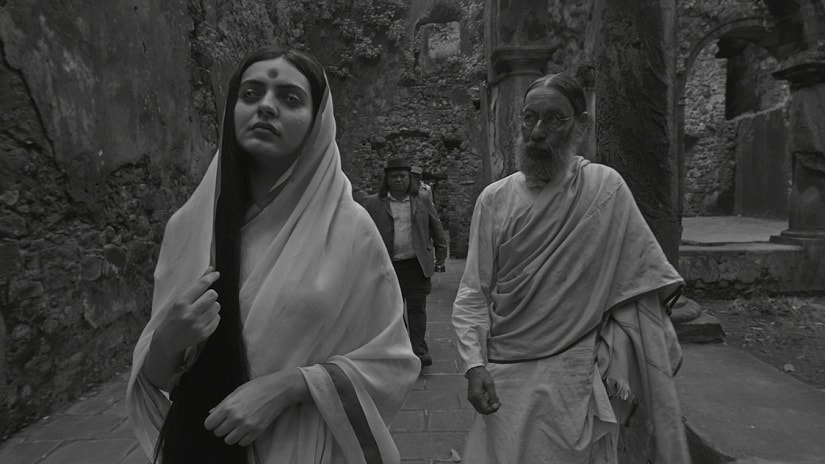Palace of Horrors is an 11-plus minute horror short that’s part of The Field Guide to Evil, an anthology film that premiered at the 2018 edition of the SXSW Film Festival. The Field Guide… features the work of eight genre filmmakers from around the world, each contributing a short film that revolves around a dark folk tale from their country. The Indian entry, Palace of Horrors, is directed by Ashim Ahluwalia, and remains suffused with the meticulously curated atmosphere that underlies his films. It is the work of a director fully cognisant of the opportunities and tropes that comprise the horror genre. In realising a fairly straightforward story in a luminously straightforward fashion, he pays a quiet homage to the genre while exploring ideas of greed and the limits and danger of forbidden knowledge and human ambition. The year is 1913. HB Gentry, the famous circus agent, and his assistant, James Buck, are going deep within the jungles of Bengal. Professor Ghosh is leading them to the ruin of an old palace that houses human curiosities who had been kept by a king for his own pleasure. A sadhvi appears to be the caretaker of the ruins. Ghosh tries to convince her to sell the malformed people to Gentry at a handsome price. A tale about the clash of mercantilism and tradition and the disregard for superstition ensues. [caption id=“attachment_4399935” align=“alignnone” width=“825”]  Palace of Horrors still, from The Field Guide To Evil[/caption] It is seemingly irresistible not to hark back to Tod Browning’s seminal Freaks while watching a film revolving around human curiosities. Similarly rendered in black and white, Ahluwalia’s film chooses to propel the narrative through the conflict between Buck and Gentry’s differing views of the stories surrounding these people. Gentry dismisses the legend woven around them by Ghosh as easily as it horrifies Buck. The outstanding sound design, which deserves a special mention — combined with Ghosh’s tellings and Ahluwalia’s keen eye for framing the lush forest — conjures eeriness at every corner. The menace and the feeling of being a step or two away from terror being unleashed that underlay a majority of Freaks is present here. Had Mark O’Gleby’s portrayal of Gentry been as assured as the direction, it’d have become difficult to tear away one’s eyes from the screen. Palace of Horrors is a film completely aware of the legacy of the horror genre. It approaches the subject in a classical vein. The pace is deliberate, the characters seem assailed by torpor, their movements slow, and everything and everyone appears shrouded by a slowly spreading dark. A particularly beautifully composed shot of the sadhvi standing next to a window, her hand languidly and eerily holding a lantern in the early evening comes to mind. Ahluwalia’s knack for capturing the beauty of uncertainty and the charm of the unknown and the unknowable is present in these moments. She leads a constantly entreating Professor Ghosh and the others to the curiosities whom she calls God’s children, inevitably, but not without warning, leading the unbelievers to their doom. It is to Ahluwalia’s credit that he refuses to take sides in a film that could easily — perhaps even fashionably — have veered towards the intellectual investigation of the ineffable. In doing so, his commitment to the captivation and awe inspired by the folk tale remains untarnished. The beauty of the individual shots and the simplicity with which the narrative unfolds again celebrates the charms of this most primal form of storytelling. He begins and ends the film with still photographs, and ever-so-gently discards linear narrative to follow two parallel storylines at the end, thereby introducing a measure of new forms of storytelling within a classical mould. This gentleness of touch, above all, makes Palace of Horrors so absorbing, in spite of the conventional story and the welcome absence of jump scares. The ideas never threaten to disturb the story’s natural arc and still manage to circulate freely. The skeptic would perhaps say that these ideas could have been explored more deeply. Ahluwalia could indeed have benefited with a longer runtime, drawn out the sadhvi’s character — delineated with movements and gestures so commendably — and delved into the lives of the human curiosities. However, that can hardly be termed a grouse. For Palace of Horrors is an ably mounted horror film that sticks to its guns, respects genre and delivers on its promise. The Field Guide to Evil from MicroVentures on Vimeo.
Palace of Horrors is an ably mounted horror film that sticks to its guns, respects genre and delivers on its promise.
Advertisement
End of Article


)
)
)
)
)
)
)
)
)



